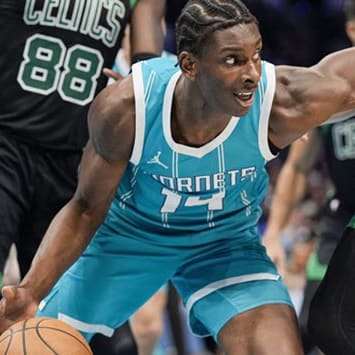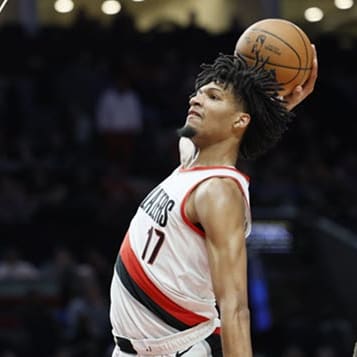This article is part of our Numbers Game series.
Perhaps we should have expected that rookies would have a down year – last summer's draft was widely considered amongst the weakest in years, and the No. 1 pick has yet to play a game. On the other hand, this year's rookie class is bolstered by some promising additions from recent classes (Embiid and Dario Saric were drafted in 2014) and some "NBA ready prospects" were drafted onto teams that seemed like great fits for their skill set (Buddy Heild on the Pelicans).
Fantasy wise, the story is the same. This year's rookie class has been a low-impact disappointment. Embiid is the only rookie who is in fantasy lineups every time he takes the court.
But we are only one month in, and we are talking about people who, by definition, have no NBA experience. When we are talking about rookies, how meaningful is the first month of a nearly six-month season?
Rookies are Rarely Fantasy Standouts
Rookies get a lot
Perhaps we should have expected that rookies would have a down year – last summer's draft was widely considered amongst the weakest in years, and the No. 1 pick has yet to play a game. On the other hand, this year's rookie class is bolstered by some promising additions from recent classes (Embiid and Dario Saric were drafted in 2014) and some "NBA ready prospects" were drafted onto teams that seemed like great fits for their skill set (Buddy Heild on the Pelicans).
Fantasy wise, the story is the same. This year's rookie class has been a low-impact disappointment. Embiid is the only rookie who is in fantasy lineups every time he takes the court.
But we are only one month in, and we are talking about people who, by definition, have no NBA experience. When we are talking about rookies, how meaningful is the first month of a nearly six-month season?
Rookies are Rarely Fantasy Standouts
Rookies get a lot of attention, but from a fantasy perspective, their impact is easy to overstate. Typically, only one or two players emerge as season-long every night fantasy starters.
The 2015-16 season was a strong one for rookies. Karl-Anthony Towns was a top-20 fantasy player, and Kristaps Porzingis ranked inside the top 60. Two players finished ranked 80-90, and two more inside the top 140. That was an above-average year, and still only six players averaged season-long fantasy value in standard 10-team leagues.
In 2014-15, Nerlens Noel ranked among the top 60, but the next three rookies were down between 101 and 120. In 2013-14, both Michael Carter-Williams and Victor Oladipo ranked inside the top 70, yet the third-best rookie was Trey Burke, who finished the year outside the top 140. The 2012-13 season saw both Damian Lillard and Anthony Davis debut as top-40 players – after those two, only one more player cracked the top 140, Bradley Beal, all the way down at 114.
Studs Emerge Early
The last four seasons, seven rookies finished the season as top-70 players, qualifying them starters in season-long leagues of any size. Those players were mentioned above – Towns, Porzingis, Noel, Carter-Williams, Oladipo, Lillard and Davis. One month into each of their rookie seasons, every single one had established themselves as the cream of the rookie crop.
After the first month of games, Davis outranked Lillard by a tiny margin – by the end of the season, that would flip, and Lillard would edge out Davis for the season's top fantasy rookie honors. The other five of these players had all achieved their eventual season-ending rank among rookies after the first month. Except for Noel, these players were not just the top rookies, but already top-70 overall players after one month.
If these patterns hold, then Embiid would remain both the best rookie and the only top-70 player. The biggest caveat is last summer's first overall pick Ben Simmons, who has yet to play a game, but is expected to make his debut in January.
The Rookie Class Improves
Probably more than any other subgroup of the NBA, rookies improve. This is not particularly insightful on its own, but the numbers supporting this claim carry some fantasy usefulness.
The table below shows the average fantasy ranking of the top 12 rookies during the first month of play, the season-long average and the last month of the season. As you can see, each year, the overall improvement is drastic.
| FIRST MONTH | FULL SEASON | FINAL MONTH | |
| 2015-16 | 139 | 127 | 114 |
| 2014-15 | 177 | 157 | 94 |
| 2013-14 | 201 | 192 | 133 |
| 2012-13 | 150 | 158 | 135 |
The general trend of improvement is striking for how noticeable it is. Across the board, the final month figures are vastly superior to the first month and full season figures. 2012-13 is the only season that did not show steady-state improvement, and that season is notable for the collapse of Michael Kidd-Gilchrist – Kidd-Gilchrist began his rookie season as top 80 player, but fell precipitously as the season wore on.
In most settings, after the first month of each season, the top 12 rookies averaged a ranking that would place them on the fantasy waiver wire. By the final month of the season, they averaged a ranking that would have them on rosters – in starting lineups for the last two season.
This early in the season, one of the most important takeaways from this table is found looking at the middle column. Only 2015-16, which boasted one of the strongest rookie classes in recent memory, had an average ranking among top rookies that merited season-long ownership. Most seasons, few rookies will warrant such ownership.
After the Elite, the Rookie Rankings Shuffle
In each year that I studied, the rookies seem to fall into two categories – the elite, made up of the seven players listed above, and everyone else. Amongst the elite, in addition to holding their early season rookie ranking, the general trend was that players improved after the first month, though usually not by very much. Notably, these elite players saw very little change in their minutes load after the first month – only two Lillard and Towns saw a change of more than one minute, and their changes were increases of two and four minutes, respectively.
Among the rest of the rankings, the players shuffled position. Few players moved in or out of the top 12 – put differently, by the end of the first month, almost all of the rookies who might become fantasy relevant had already shown themselves. But the order of rookies 3-12 (or 2-12, in 2014-15) changed significantly. For example, every year, the top non-elite player after one month fell at least four spots by season's end (important note: this is not a mathematically predictive trend, just a useful example; this should not be interpreted as an indictment of current No. 2 rookie Domatis Sabonis).
One of the major causes for this shuffle seemed to be changes in the workloads of the non-elite players. This explanation makes intuitive sense – the best players are good enough to warrant stable roles in the rotation, and a coach will arrange his other pieces around them; everyone else is some degree of good-enough-to-play, but their opportunity is more impacted by the production and availability of those around them.
How Predictive is a Rookie's First Month?
For most rookies, not very. Players show the kind of skill sets they have – a good passer in the first month is probably going to stay a good passer. However, very few rookies end the season with a fantasy ranking similar to the one they had after the first month.
Part of this is because so much of fantasy performance is dependent on minutes. Very few rookies see stable workloads all season long. Many see increased minutes later in the season, and those increased workloads do not necessarily go to the players who were most productive early.
The biggest takeaway here is that, outside of Embiid – and possibly Simmons, who remains a giant unknown – no rookie is likely become a major fantasy force. On the flip side, however, though the rest of 2016-17's rookie class has yet to make much of a fantasy impact, that is not necessarily an indication that they will remain low impact.
Action Items
If you are like my friend who proofreads these columns, you might be thinking, "OK, so, basically, you're telling you that the first month of rookie data doesn't matter much, because other data shows that rookies improve unpredictably, except for a few players? How do I act on that?"
First, yes, you have accurately summarized my findings. Second, here are some ways to act on my findings:
1. If you have Embiid, expect him to stay productive and to improve as his minutes limit increases.
2. If you have held Simmons this long, you should probably keep doing so. But once he returns, it should not take long for it to become clear whether he is a fantasy must have, or just another player who's productivity is dependent on his surroundings.
3. All other rookies are not likely to merit sustained season-long ownership. Allowing other teams to use precious roster spots on rookies, waiting, hoping for eventual breakouts is probably a good strategy. You will probably get better production if you rotate that spot with the best available waiver players.
4. Rookies do tend to improve, and it is unwise to assume that just because one struggled early, that he is doomed to be unproductive the whole season. Make sure to keep your analysis of a rookie's ability flexible.
Finally, know your league. These action items are guidelines, not rules. If you are in a keeper league, action item 3 becomes less helpful. If your league-mates tend to overvalue older, established players, then action items 3 and 4 become more valuable, and you can wait to grab rookies until they are truly useful.










